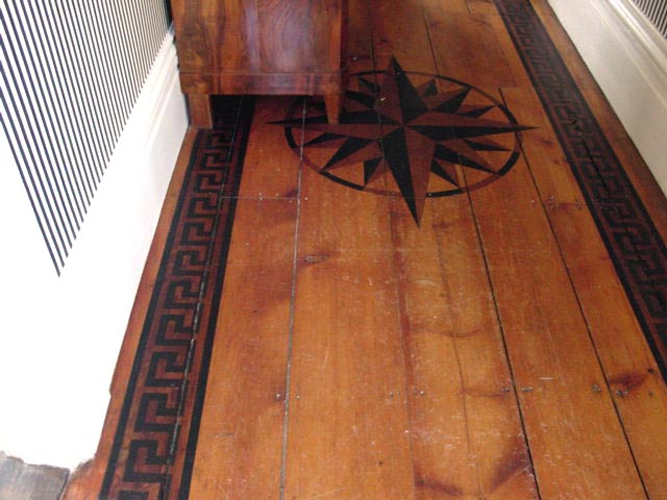With my bag of tricks, most repairs to any wood, stained or painted surface are usually straightforward and a matter of selecting the corrective color or texture and then blending in the finish.
Take this well worn piece for example. It was being used as a coffee table and probably getting a little more abuse than it was designed for.
Without too much preparation, I was able to apply an opaque glaze finish which blended in the scuff marks and made the piece look as good as new. When it was dry I applied a durable polyurethane protective finish to prevent further damage.


This next situation was a little more tricky. The floor and its border had been badly damaged by paint stripper, which had been applied to the adjacent baseboards.
There was enough of the border design left for me to tape up and paint in the black greek key design and then blend in the brown glaze over the top. The customer wanted the floor to look as close as possible to how it looked before it was damaged and by the time I was finished and a protective top coat was applied, the painting contractor was able to sleep at night again.

After – repainted border

After – floor looks the same as it did prior to damage
The following restoration project involved an antique staircase that had started its life in an opera house and relocated to a home on Long Island, NY. Over the years, its original plaster and gesso panels and wooden trim had been repaired and touched up but it had started to crumble and need a major cosmetic overhaul.
We scraped back the loose and flaking surface, repaired all cracks and then we rebuilt the original texture of the plaster and gesso finish. Once we had a stable surface and corrected surface texture, we repainted and faux finished all repairs to blend in with the original finish that remained on the unaffected surfaces.

Repaired and refinished panel

Restored finish ties in with surrounding trim
Metallic surfaces are practically impossible to repair with paint and products. The repair might match perfectly in one light but, due to the nature of the material, might look totally wrong from a different angle. I can never guarantee being able to repair or restore any metallic finish, but sometimes I get lucky.
This was a steel countertop in a restaurant where columns prevented the fabricator’s use of an axle grinder tool to produce take the brighter, polished finish right up to the edge of the columns. The customer was unhappy with the dark, original metal finish being so apparent around the base of the columns and asked me if I could help. In this instance, I was able to find a metallic wax which blended in perfectly.


Whether it’s wear and tear, accidental damage or challenges presented with manufacture or installation, I usually have a way to camouflage the unsightly or restore the original finish.
Take this well worn piece for example. It was being used as a coffee table and probably getting a little more abuse than it was designed for.
Without too much preparation, I was able to apply an opaque glaze finish which blended in the scuff marks and made the piece look as good as new. When it was dry I applied a durable polyurethane protective finish to prevent further damage.


This next situation was a little more tricky. The floor and its border had been badly damaged by paint stripper, which had been applied to the adjacent baseboards.
There was enough of the border design left for me to tape up and paint in the black greek key design and then blend in the brown glaze over the top. The customer wanted the floor to look as close as possible to how it looked before it was damaged and by the time I was finished and a protective top coat was applied, the painting contractor was able to sleep at night again.
Before – floor damaged by paint stripper

After – repainted border

After – floor looks the same as it did prior to damage
The following restoration project involved an antique staircase that had started its life in an opera house and relocated to a home on Long Island, NY. Over the years, its original plaster and gesso panels and wooden trim had been repaired and touched up but it had started to crumble and need a major cosmetic overhaul.
We scraped back the loose and flaking surface, repaired all cracks and then we rebuilt the original texture of the plaster and gesso finish. Once we had a stable surface and corrected surface texture, we repainted and faux finished all repairs to blend in with the original finish that remained on the unaffected surfaces.
Crumbling plaster & gesso panel

Repaired and refinished panel

Restored finish ties in with surrounding trim
Metallic surfaces are practically impossible to repair with paint and products. The repair might match perfectly in one light but, due to the nature of the material, might look totally wrong from a different angle. I can never guarantee being able to repair or restore any metallic finish, but sometimes I get lucky.
This was a steel countertop in a restaurant where columns prevented the fabricator’s use of an axle grinder tool to produce take the brighter, polished finish right up to the edge of the columns. The customer was unhappy with the dark, original metal finish being so apparent around the base of the columns and asked me if I could help. In this instance, I was able to find a metallic wax which blended in perfectly.


Whether it’s wear and tear, accidental damage or challenges presented with manufacture or installation, I usually have a way to camouflage the unsightly or restore the original finish.



